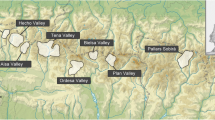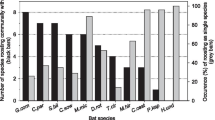Abstract
Despite potential costs of changing roost or densites, many animals frequently move between roosts or dens. Pallid bats (Antrozous pallidus) change diurnal roost sites frequently and also reportedly have a variety of cooperative social behaviors, many of which are associated with the care of developing offspring. Roost switching is likely to increase the costs of maintaining the group stability expected with social cooperation. Pallid bats roosting in rock crevices in central Oregon were studied with radiotelemetry to (1) examine characteristics of day roosts, (2) determine what ecological factors were correlated with low roost fidelity, and (3) examine the temporal stability of roosting groups of pregnant and lactating bats. Pallid bats changed roosts an average of once every 1.4 days throughout the summer. The bats exhibited seasonal shifts in roost use, occupying roosts behind thin slabs of rock in cool weather and roosts in deep rock crevices in warm weather. Roost switching was not correlated with daily variations in weather conditions or with structural characteristics of the diurnal roosts, although switching may have allowed bats to maintain familiarity with several roosts that vary in microclimate. Roost switching was positively correlated with ectoparasite load. High ectoparasite levels were correlated with lower body weights in lactating females (Fig. 3), suggesting that parasites may be costly to the bats. Roost switching may be a strategy to decrease ectoparasite loads by interrupting the reproductive cycles of those parasites that spend at least part of their life cycle on the walls of the roost. Both pregnant and lactating pallid bats frequently changed their diurnal roost location, but lactating bats tended to travel shorter distances between consecutive roosts. Lactating bats were more likely to continue to associate with particular roostmates despite changes in the location of the diurnal roost (Fig. 4) and were less likely to roost alone. Although the stability of groups of lactating bats was not absolute, evidence supported the prediction that such groups are more cohesive than are those of pregnant bats.
Similar content being viewed by others
Author information
Authors and Affiliations
Additional information
Received: 20 June 1995/Accepted after revision: 13 July 1996
Rights and permissions
About this article
Cite this article
Lewis, S. Low roost-site fidelity in pallid bats: associated factors and effect on group stability. Behav Ecol Sociobiol 39, 335–344 (1996). https://doi.org/10.1007/s002650050298
Issue Date:
DOI: https://doi.org/10.1007/s002650050298




